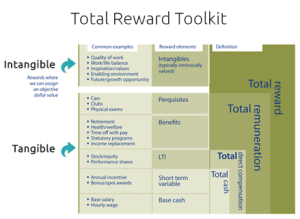These days, several companies are being plagued by low level of employee engagement. With rapidly changing global markets, technological advances, and companies doing cost reductions, job security has become a major concern for the employees. The stress levels have increased, affecting their loyalty towards the company. As a result, HR professionals are being challenged with negative attitudes, low productivity, reduced employee retention rates and increased absenteeism from the workplace.
To deal with these challenges, every organisation requires a strategic employee reward system that can address compensation, recognition, benefits and appreciation. In most of the rewards systems existing in business world these days, one or more of these elements are missing, and even when these elements are addressed, they are not aligned with other corporate strategies and core values. Employees need to know, and must be informed if they are doing bad, good, or excellent. Recognising their value, offering benefits, and providing a good life/work balance are quite effective employee motivator.
Researches indicate that less than half of the organisations have reward programs. Research also indicates that the employers that do have formal employee reward system see tangible benefits such as improved employee engagement and productivity, and improved financial performance for their organisation. Business owners often think of compensation as the top reward, however the reward system needs to be based on compensating someone for the contributions being made that are important for the organisation. These could be thinking out of box, outstanding innovator, outstanding philanthropist, the risk taker, multitasker, most Resilient, or for enhancing customer relations. A recent survey by McKinsey indicated that the three most effective motivators than highest-rated financial incentives included praise from immediate managers, leadership attention and chance to lead task forces or projects. Employee reward system should be based on the values, vision and goals of the organisation, and modifications must be done to make the entire process special and rejuvenating for the employees. A well-balanced reward system must recognize the performance and behaviour of the employees. As performance is directly linked with the final outcomes, it is easier to address. Appreciation and Recognition are the most underrated rewards, and are ignored by most businesses. These are high-return and low-cash ingredients, and must be an integral part of a well-balanced reward system. The simple act of expressing gratitude and acknowledge the performance can have positive impact on the employees, increasing their morale, and improving their performance.
Employee reward system should be based on the values, vision and goals of the organisation, and modifications must be done to make the entire process special and rejuvenating for the employees. A well-balanced reward system must recognize the performance and behaviour of the employees. As performance is directly linked with the final outcomes, it is easier to address. Appreciation and Recognition are the most underrated rewards, and are ignored by most businesses. These are high-return and low-cash ingredients, and must be an integral part of a well-balanced reward system. The simple act of expressing gratitude and acknowledge the performance can have positive impact on the employees, increasing their morale, and improving their performance.
Several Fortune 500 companies have been using some fantastic ideas to reward and retain their employees. Some of the key trends of the employee reward programs include:
1. Google offers free food, outdoor sports facilities, indoor games etc. to its employees Additionally, irrespective of the tenure with the company, if the U.S employee passes away while working with the company, the partner or spouse get 50% of the salary every year for the next ten year.
2. Developer of people-management software, Ultimate Software gives free vacation to the workers every two years.
3. NetApp Vice-Chairman Tom Mendoz calls 10-20 employees every day to give them special recognition, and thanks them personally for doing something extraordinary.
4. Chesapeake Energy paid bonus of more than $8 million to around 6000 employees for following safe work practices.
5. Caliper, a talent management firm gives employees paid time-off in the form of vacation
6. Checkers and Tokyo Joe’s give their outstanding employees an all-expense paid off week-long vacation
7. Employee incentive platform Snowfly gives its employees game tokens to promote productive behaviour, and points earned in the games can be converted to cash
8. To help employees deal with the work related anxieties, employees at Mayo clinic get massages in their stress-free zone.
9. Intel offers eight-week paid sabbatical and $50,000 for tuition reimbursement to its employees, Aflac hosts annual appreciation week, GoDaddy takes employees off-site during paid work hours for different fun activities, Producers Assistance Corporation offers reloadable gift cards, and Zappo has “Monthly Hero” program.
Organisations are also using more innovative methods such as recognition and reward using the social media, early recognition to improve employee retention, creating a culture of rewards and recognition with a clear tie to the core values of the company, investment in staff engagement campaigns spanning the entire business, rewarding longest-serving employees to make them feel valued and encouraging other staff members to be loyal, extending the reward to employee’s spouses and families etc.

Looking at these incentive programs, it can be deduced that employees want to look beyond the pay check, and expect rewards with diverse blend of incentives, business practices and benefits that help them stay loyal and motivated. A well-balanced reward system can benefit both employees and the organisations, creating a competitive advantage for the companies.
• Developers, engineers, and managers from companies of all sizes
• Technical executives looking out for the bottom line
• CTOs and CIOs seeking to streamline operations
• Technology evangelists and entrepreneurs pushing enterprise boundaries
• Researchers and academics
• Companies and professionals engaged in the mobile development and performance ecosystem